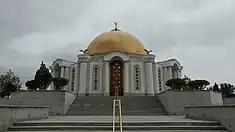| Türkmenbaşy Ruhy Mosque | |
|---|---|
| Religion | |
| Affiliation | Islam |
| Status | Active |
| Location | |
| Location | Gypjak, Ashgabat, Turkmenistan |
| Architecture | |
| Type | Mosque |
| Style | Islamic |
| Completed | 2004 |
| Capacity | 10,000 people[1] |
Türkmenbaşy Ruhy Mosque (Turkmen: Türkmenbaşy Ruhy Metjidi), or Gypjak Mosque,[lower-alpha 1] is a mosque in Gypjak, Turkmenistan and the resting place for Saparmyrat Nyýazow, the leader of Turkmenistan from 1985 to 2006.[2] The mosque is located about 7 kilometres (4.3 mi) west of the capital, Ashgabat, on the M37 highway.
Overview

The mosque, constructed by the French company Bouygues, was built in the home town of President Saparmyrat Nyýazow. It opened on 22 October 2004, and was built by Nyýazow with a mausoleum in preparation for his death. Nyýazow died two years later, and was buried in the mausoleum on 24 December 2006.
The mosque has been at the center of controversy as scriptures from both the Quran and the Ruhnama (The Book of the Soul), Nyýazow's 'pseudo-spiritual guide to life' are built into the walls. It has outraged many Muslims that the Ruhnama is placed as the Koran's equal. Indeed, despite its capacity to accommodate 10,000 congregants, the mosque is often empty as the Ruhnama inscriptions are considered blasphemous by devout mosquegoers.[3][4]
See also
Notes
- ↑ Also spelled Kipchak Mosque.
References
- ↑ Corley, Felix (4 January 2005). "TURKMENISTAN: 2004, the year of demolished mosques". Forum 18 News Service. Retrieved 25 May 2012.
- ↑ Koch, Natalie (3 October 2016). "The 'Personality Cult' Problematic: Personalism and Mosques Memorializing the "Father of the Nation" in Turkmenistan and the UAE". Central Asian Affairs. 3 (4): 330–359. doi:10.1163/22142290-00304002 – via Brill.
- ↑ Door to the Kipchak Mosque Archived 2 April 2015 at the Wayback Machine
- ↑ Türkmenbaşy Ruhy Mosque Atlas Obscura (www.atlasobscura.com). Retrieved 5 July 2019.
38°1′4″N 58°15′10″E / 38.01778°N 58.25278°E